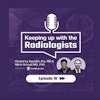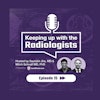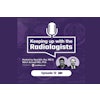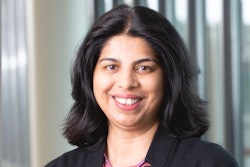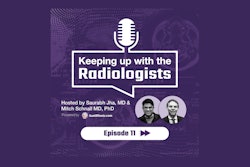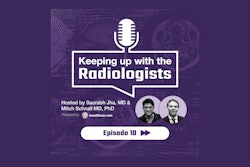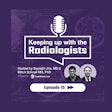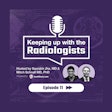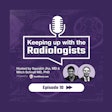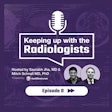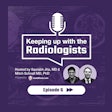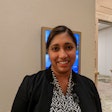Radiology resident Moses Flash, MD, is a huge fan of most Christopher Nolan films. He likes traveling and exploring, learning foreign cuisines and cooking, playing basketball and exercising, and barbering.
Like many contemplative medical students, Flash faced the difficult decision of choosing a radiology residency program. Philadelphia was an easy choice -- for flights, relative safety, and proximity to family on the East Coast. Once in, Flash also faced a surprising reality that radiology rotation wasn't what he expected.
"I hoped to match myself where I wanted to go, where the mission of the department and direction of the department was aligned with my career direction and aspirations," Flash, a future interventional radiology fellow, recalled for Saurabh Jha, MD, in Episode 12 of the Keeping Up with the Radiologists podcast. "I did not look at the job market at all. I was just intrigued by what I saw in the hospital."
As AuntMinnie has reported, radiology educators have been advocating for early and consistent exposure of medical students to radiology, well before their third and fourth year of medical school.
Some suggest medical school students should observe radiology more leading up to their clinical clerkship, to help ensure the future of the field.
Greater collaboration with other departments is also seen as beneficial, for example with internal medicine and surgery bringing radiologist-led standardized interactive teaching sessions into established clerkship curricula.
Many radiology department leaders would probably agree that radiology spans across all medical fields of study and adds depth to any medical specialty. It helps when clerkships in diagnostic radiology are designed to be relevant and suitable for all medical students, regardless of their ultimate career choice or interests.
Originally from Hartford, CT, Flash attended Williams College and then Harvard Medical School. He interned at Memorial Sloan Kettering Cancer Center in New York City and at Penn Medicine is pursuing interventional radiology, gravitating toward interventional oncology with interests in device development and the business of radiology.
"There was a lot in the field of just radiology -- diagnostic radiology -- that I fell in love with," Flash explains during this episode. "It felt to me like it was actually pure medicine: looking at images, looking at the symptom profile of the patient, matching it with the images, and coming up with a differential or a unique diagnosis that could help take care of this patient.
"Unfortunately, a lot of medical students don't really get a good perspective of what radiology looks like going into the rotation," Flash said. "Because I was so interested in interventional at that time, I asked my upperclassman peers what they did to prepare for the clerkship." Listen to the episode to learn from Flash's experience, including:
- Four tips for preparing for clerkship
- Fielding the interview
- The big question: Why do you want to be a radiologist?
- Flash's study experience
- Going from internship to first year and then second-year resident
"The volume of mental energy one has to use day to day is something I didn't anticipate," Flash said, adding that the mental fatigue depended on the day, the rotation, and the number of imaging studies.
"Radiology is a very cerebral field," Flash explained. "In order for us to get better as radiologists and as trainees, we need to go home and read and study, and it's a burden that I wasn't expecting in med school -- how much that mental fatigue and drain can have on your mind when you're trying to learn. ... The first few months is about finding out how to study, what works for you."
For the resident, radiology is different and unique, according to Jha and Flash, who also discuss the development of individualized and fine-tuned "search patterns" as a routine approach to imaging studies. Also, generational attitudes may differ when it comes to using standardized templates and free text reporting.
"If you're going through those macros and you're simply filling them in mindlessly, it's probably detrimental to your long-term learning," Flash cautioned radiology trainees. "But I think there is something to be said about going through those macros and using them as a guidepost ...."
Flash also discusses the steps he took to make himself as competitive as possible for the interview process. He applied to between 60 and 80 programs before landing at the University of Pennsylvania.
"I was always interested in cost-effectiveness research," he said for an example. "It was a conscious decision to make myself a better applicant for application season."
More impressions:
{02:13:11} Starting the path
{06:41:01} Clinical clerkship in radiology
{13:47:14} Cognitive stress
{16:34:06} First year
{27:43:00} Search patterns
{31:11:03} Making yourself competitive
{33:31:21} Interviewing
{34:50:19} Why do you want to be a radiologist?
{39:59:24} Selecting a program
{43:01:18} Living in Philadelphia
Guest:
Moses Flash, MD, is a radiology resident and future interventional radiology fellow.
Host:
Saurabh (Harry) Jha, MD, is an associate professor of radiology at the Hospital of the University of Pennsylvania. Jha obtained a master’s degree in health policy research from the Leonard Davis Institute at the University of Pennsylvania. He earned his medical degree from the United Medical and Dental Schools of Guy’s, King’s, and St. Thomas’ Hospitals. Jha developed Value of Imaging, a set of radiology educational resources.
This episode of Keeping Up With the Radiologists is brought to you by AuntMinnie.com in collaboration with Penn Radiology. The series is also available on Spotify, YouTube Music, and Apple Podcasts. Check back for new episodes!

